Full Guide to Snorkels and Masks
The very first piece of equipment you will need to really go exploring in the waters of the world is a good mask and snorkel.
With a good mask you will be able to see all of the creatures, shipwrecks, and coral that you like while being comfortable and confident. You need to be able to see well in order to be able to enjoy snorkeling and experience your aquatic environment to the full potential, and you need to be able to breathe comfortably at the surface to be able to see all those beautiful things!
The best snorkels are well balanced, comfortable in your mouth, and breathe effortlessly. As in all of my articles, we will go through all the key features and things to think about when you are buying a mask and snorkel so that you can get the perfect fit and function.
Yes, I am going to recommend that you spend a bit more money to get a well made mask and snorkel that is backed by a known manufacturer. Why do I keep harping on this? Because it really does make a difference; I have owned quite a bit of equipment over my dive career and the gear that’s a bargain in the beginning usually ends up being the stuff I have to replace a lot sooner.
Masks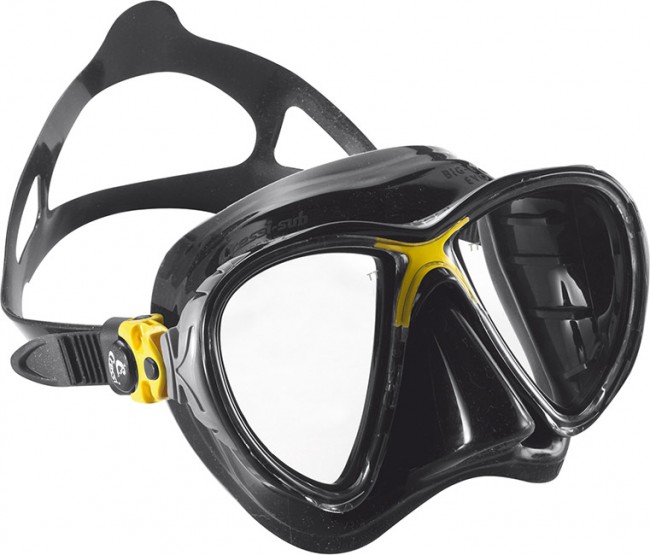
Now don’t get me wrong, there are a lot of masks out there that are affordable, durable, and most importantly comfortable. Price does NOT always imply quality, but I am saying that if you buy a mask for ten dollars at your local sporting goods supercenter, you are definitely going to get ten dollars of performance and life out of it. Scuba masks are made to much higher standards than discount pool toys. Starting your dive kit with an expertly made mask and snorkel will have your first step on every dive going in the right direction.
Everyone has a unique face; the shape, curves, and size all play a factor in getting mask to fit properly and comfortably. You are probably thinking “How am I supposed to know which masks are better for which faces and how do I know what type of face that I have?”
The first and foremost feature is fit. Without a great fit all the other features will be a secondary consideration. It won’t matter the volume or the lens coating or the field of view; if you have a leaky mask it will constantly distract you and can actually pose a safety hazard. When you are concentrating on clearing your mask throughout the dive, you will not be paying as much attention to things like your air consumption, depth, buoyancy, and buddy. Of course, you will also miss all the cool things that are the reason you went diving in the first place. Different frame sizes, skirt designs, lens configurations, and straps can make for a dizzying array of choices, so let’s get started!
The main parts of a mask are pretty simple: you have the lens(es), the strap, the buckles, the frame, and the skirt.
The Skirt
This is the flexible part of the mask that fits to your face, and is the key to a perfect fit. You are looking for a comfortable skirt that seals smoothly onto your face with no gaps whatsoever. Manufacturers these days are inventing proprietary methods and materials to make skirts as flexible and comfortable as possible. The Cressi Big Eyes Evolution Black is a great example of these technologies.
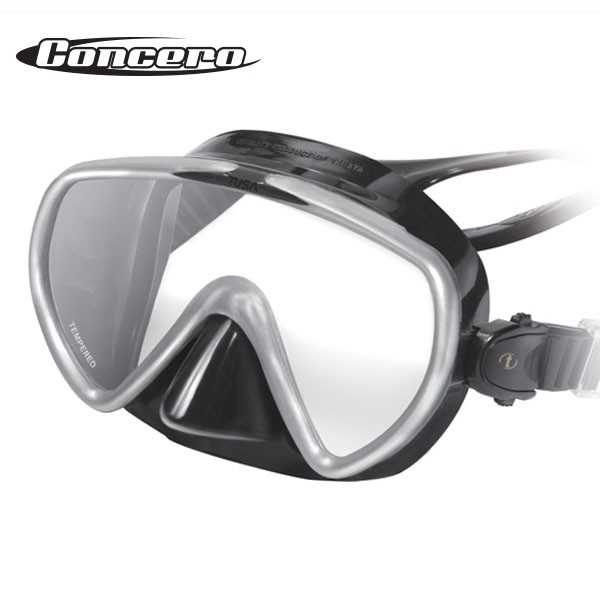 A good test is to place the mask on your face without the strap on and inhale through your nose. A well-fitted mask will suck up to your face and will remain there even when you move your hand away. If the suction breaks, then the mask is not sealing properly.
A good test is to place the mask on your face without the strap on and inhale through your nose. A well-fitted mask will suck up to your face and will remain there even when you move your hand away. If the suction breaks, then the mask is not sealing properly.
A point of detail on this: if you have a mustache or beard, you may find that some of your facial hair is trapped under the skirt and not allowing the mask to form a complete seal. There are two ways that I have had success with in dealing with this problem. First (and much more reliably), if you wish to keep your beard or mustache, you can shave a thin strip clean directly under your nose that is just wide enough to allow the skirt to touch your bare skin. This will let the mask seal properly without requiring you to shave completely. If you do not want to shave (if you have a particularly fine example of facial hair I don’t blame you), there is another option. Although not as successful, this has worked for me a few times when I have forgotten to shave the strip below my nose and I am out on a dive boat. Simply smear a generous amount of silicone grease into your facial hair on the area underneath your nose where the skirt comes into contact with it; this will temporarily fill the gaps in the hairs and allow the mask to seal. THIS IS NOT the same as silicone sealant! Petroleum jelly can damage the skirt over the long term, so I don’t recommend it. This latter method does have a significant drawback; if you have to remove and replace your mask, or repeatedly move the skirt, the water will wash away the silicone grease and you will lose your good seal. I recommend this method only as a stopgap measure when you have no other option, as it is no substitute for a properly sealed mask. Take special care to make sure that you are completely comfortable with clearing your mask with this method, and that you are prepared to deal with the mask seal becoming suboptimal during the dive. I do not recommend cinching the mask strap down extra tight to hold the mask against your face. You will not be comfortable and if your mask strap breaks you have a whole new situation to deal with, easily ending your dive and possibly your day if you do not have a replacement strap (this is one of many reasons to have a save-a-dive kit!!). Unfortunately, there is no magical formula to determine what mask will fit you without trying it on. The pros at your local dive shop will be more than happy to assist you in finding the perfect fit for you.
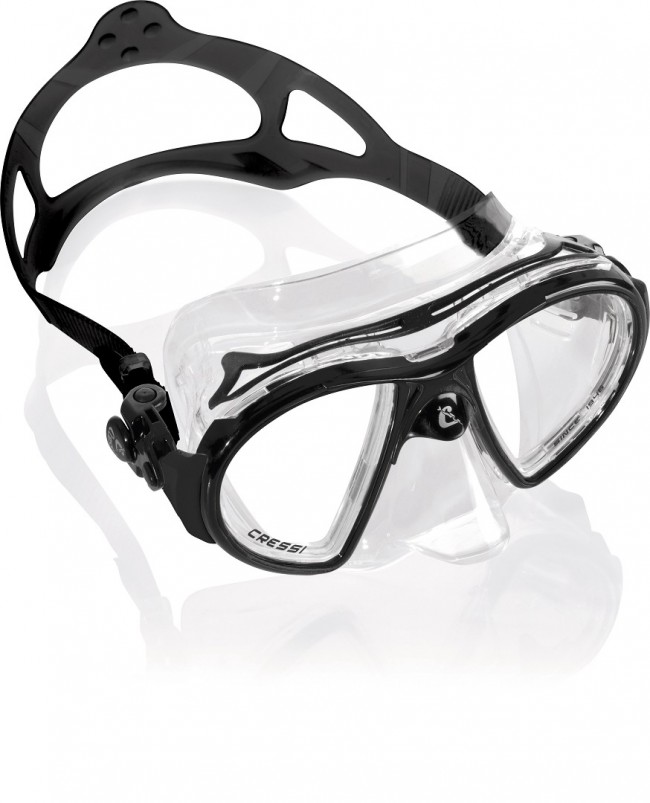 Skirts can be further divided into a few more sub-categories. There are translucent skirts and opaque skirts. Translucent skirts are clear or lightly tinted, and will allow lots of light into to the mask as well as allow some more peripheral vision. Keep in mind that since the silicone of the skirt is not designed with optics in mind, this peripheral vision will not be very precise. Some divers prefer these kinds of skirts because they feel more open. The extra light is also a good feature for those divers who have some issues with claustrophobia or feel as though masks constrict their vision. Opaque skirts do precisely the opposite and block light from coming into the sides of the mask. Photographers and divers who are interested in videography often prefer these masks because they reduce distractions and allow them to focus on the field of view directly in front of them. The functional seal of the mask should not be affected by the visual qualities of the skirt. Personally, I own masks that have both kinds of skirts and I use them for different kinds of diving. For a good comparison, look at the Cressi Air Crystal versus Air Black regarding clear versus opaque skirts. For the beginning diver, I have seen more success and comfort with my students when they have translucent skirts, but this is a matter of personal preference.
Skirts can be further divided into a few more sub-categories. There are translucent skirts and opaque skirts. Translucent skirts are clear or lightly tinted, and will allow lots of light into to the mask as well as allow some more peripheral vision. Keep in mind that since the silicone of the skirt is not designed with optics in mind, this peripheral vision will not be very precise. Some divers prefer these kinds of skirts because they feel more open. The extra light is also a good feature for those divers who have some issues with claustrophobia or feel as though masks constrict their vision. Opaque skirts do precisely the opposite and block light from coming into the sides of the mask. Photographers and divers who are interested in videography often prefer these masks because they reduce distractions and allow them to focus on the field of view directly in front of them. The functional seal of the mask should not be affected by the visual qualities of the skirt. Personally, I own masks that have both kinds of skirts and I use them for different kinds of diving. For a good comparison, look at the Cressi Air Crystal versus Air Black regarding clear versus opaque skirts. For the beginning diver, I have seen more success and comfort with my students when they have translucent skirts, but this is a matter of personal preference.
Frame & Lenses
The frame and lenses are the next consideration. The frame is the skeleton of the mask that connects the lens to the skirt and provides the main structure of the mask. Frames are available in several shapes. Frames should be sturdy and securely attached to the lenses. A cheaply made frame will not stand up to the rigors of diving over time, and will be no match for rough luggage handling if and when you do travel to dive. For a VERY rugged framed mask, the Aqua Lung Teknika is hard to beat.
There are two main kinds of lenses for masks: single and double lens. A single lens is a continuous piece of glass that goes across the entire visual field. This type of mask offers a wide field of view and no gap in the center of your vision for a center frame support. The other option is a multiple lens mask. This kind of mask will split the visual field into two separate lenses. A major benefit of this kind of mask is the lower volume or air space inside the mask. A lower volume mask will be easier to clear since you have to move less air to much the water out. There are some single lens masks that are relatively low volume, but as a general rule the double lens masks are the smaller volume of the two.
Double lens masks offer excellent fields of view as well, but there will be a divider in the center of the mask that may obscure your vision. Most dive mask manufacturers take this into consideration, and go to a great deal of effort to minimize the visual obstruction. The Cressi Nano Black is a very low volume mask designed for spearfishers and free divers.
As far as the shape of the lens or lenses go, this is again an area of personal preference and depends on the mask design. For example, lenses that are teardrop shaped will have a longer visual field from top to bottom, so looking down may not require as much head movement. Other masks have smaller lenses, but since they are so low volume, the lenses are closer to your face and so the field of view is still fairly good. For those of you who wear glasses or contacts, replaceable corrective lenses are available for these types of masks. If you use reading glasses, you can get smaller reading lenses that stick to the inside of the mask without needing to go through the effort and expense of full corrective lenses. These corrective lenses are available as standard prescriptions direct from the manufacturer or you can have them custom ground to your exact specifications by a few aftermarket suppliers. A good lens maker will take into consideration the natural magnification effect of the water into their procedures. I spent the extra money and ordered a pair of lenses ground to my exact prescription and I love them! Since I wear contacts, this mask is wonderful for when I am diving on a boat; no need to worry about losing a contact if my mask floods, and no need to keep track of contacts on the boat. I just bring a pair of glasses for when I am topside and I am good to go! Lens coatings are also available on some masks; much like driving glasses, these lens coatings are usually designed to do one of a few things: they will increase contrast in cloudy water or other specific conditions, or reduce reflections and glare. The Mares X Vision is one to look at for both the prescription lenses and the coatings.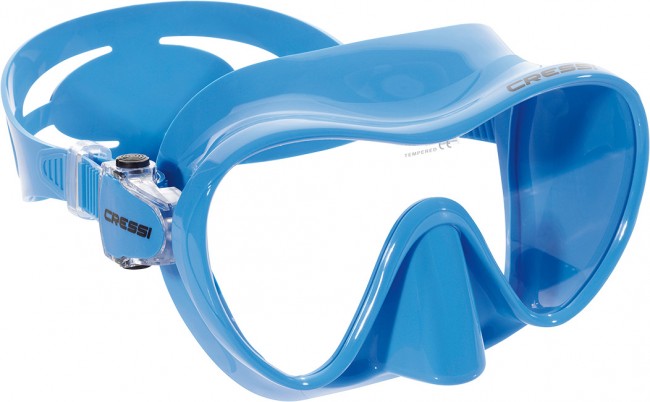
The third category of masks are referred to as “frameless”. In these masks, the lens is bonded directly to the skirt without a frame. These masks tend to be very low volume and just as comfortable as framed masks, with less weight on the face than a framed mask. However, the lack of a frame does make them more susceptible to breakage in my experience, and since they have no way to remove the lenses, you cannot replace them with corrective lenses or if the lenses are damaged. I have an Atomic Aquatics Venom frameless mask that is a dream, and Cressi’s F1 is also a frameless mask that I really like.
Buckles & Strap
The last feature to look at is the buckles and the strap. There are several buckle designs on the market today, but there are some key features to look for if you want your mask to be as trouble free as possible. First, look for sturdy construction. Thin plastic studs where the strap threads through will be more likely to break and wear out, and it is NOT a fun day when you have to end diving because of an inch long piece of plastic failing. I have had this happen to me after hiking down a very long staircase to the beach with all of my gear, only to break the buckle of my mask when putting it on; to say I was less than happy would be an understatement. So, take the time to really look closely here. You want solid construction of all the components of the buckles.
The next thing to look at on the buckles is their freedom of movement. Do they just fold in and out; do they pivot; are they hinged? Not all buckles move in the same ways, so do not make the mistake of thinking all the buckles are the same. If you have a larger head, or if you prefer to wear your mask strap a little higher or lower than the average diver, you will want buckles that will allow you to do this without relying on the strap to do the flexing. Are the mounting points of the buckles to the mask rugged? A perfect buckle is useless if the post it is on is flimsy or fragile. The strap itself should be thick yet flexible, and the ribs where the strap adjusts in length should be substantial. Thin straps will stretch out and fail much more quickly than a more robust strap, and everyone has heard me talking on and on about how ruthlessly harsh salt water is to equipment. Thin ribs will not hold the strap length securely, and it is irritating to have to constantly adjust the strap to get it to the proper length for your head.
The area where the strap widens in the back is another consideration. If the strap splits into two here for a section, are the split strips wide enough to stay put and not dig into your head? The split is designed to work with the curve of your head to keep the mask fitted snugly, but if the split is too long for your head or the split section widens at the wrong angle, you will be back to the section above where you are having to regularly adjust your strap. The straps on TUSA masks curve in three dimensions instead of just a flat strap, so they will do a great job curving to fit the natural contours of your head.
To sum it up, if you are getting a mask and you only have one feature that you really care about it should be HOW THE MASK FITS YOU. A mask will all the latest bells and whistles made of mermaid scales and gold will be useless if it fills with water every dive and isn’t comfortable to wear. The second points to look at are the lenses and frame. You are looking for lenses that do not obstruct your vision and a frame that is sturdy and securely attached to the skirt. Third on your list is the strap and the buckles. You want a strap that is thick yet flexible, with rugged adjustment ribs and a good fit for your head shape. The buckles should swivel enough to allow the strap to move to a comfortable and secure position on your head, securely hold the strap at wherever you adjust it to, and be ruggedly attached to the mask.
Snorkels
Now that you have a good primer for mask shopping, you will need a snorkel. You might think that all snorkels are the same: a generic mouthpiece and tube that goes on the mask. Quite the opposite! Snorkels, like all other dive gear, have very specifically designed features to make your dives comfortable and enjoyable. These are simpler than masks, so let’s get started!
Mouthpiece
The first thing to look at is the mouthpiece. There are two big differences (and lots of little ones). The usual style you will see on most snorkels is the standard bite mouthpiece. Much like a mask, FIT is king. Everyone has differently shaped mouths, and you need to look to make sure that you are getting the right size for you. The length, arc, and thickness of the bite wings are what will make or break the fit. If you have a smaller mouth, you will want the arc to have a smaller radius and length. The thickness of the bite wings is also personally specific.
If you have a how that gets tired easily, or you suffer pain or soreness after snorkeling or diving, there is another type of mouthpiece available that may help you. This is a bridge mouthpiece; it is the same as a regular mouthpiece except that it has a strip of rubber that runs across the top, resting against the roof of your mouth just behind your top teeth. This allows you to keep the mouthpiece in without actively having to bite down on it during your adventures.
Much like in sports, there are also mouthpieces available in both types that you can mold to your personal bite; heated in water, they take the shape of your teeth as they cool. Almost every mouthpiece will be held on by a zip tie; carefully cut this at the latch so as not to damage the snorkel or mouthpiece with a pair of wire cutters and remove the mouthpiece if you want to upgrade, then snugly replace the zip tie and clip the excess tail.
Breathing Tube
The next is the breathing tube; this should have three sections, an angled hard turn from the mouthpiece, a flexible lower section, and a rigid upper section. All three of these should have a generous bore size so that breathing is not restricted. If the tube is too small, it will limit air flow and make breathing more difficult. The angled section should keep the mouthpiece in a 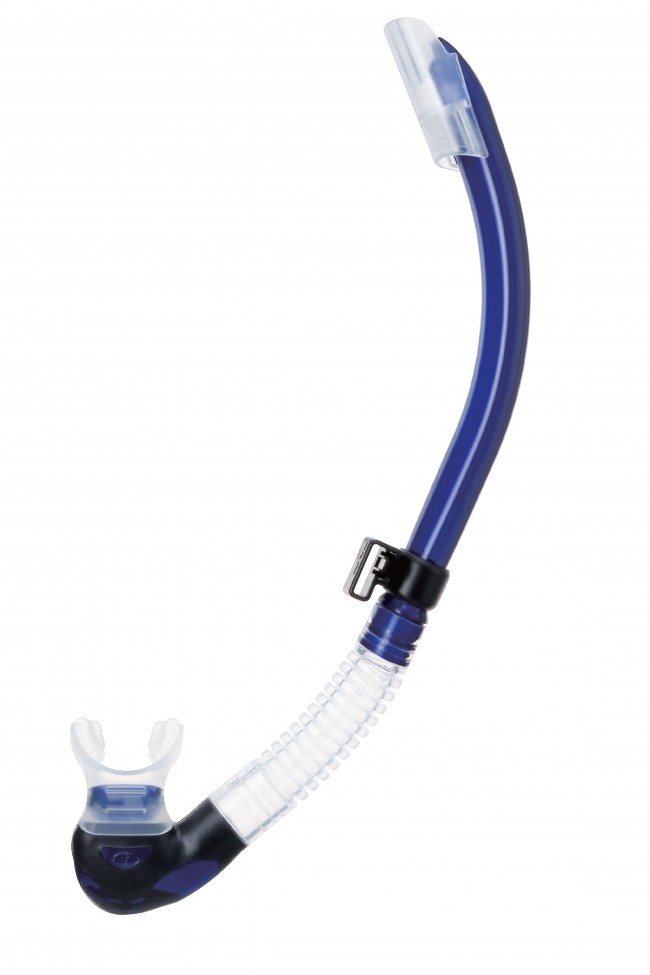 position that doesn’t put strain on your mouth or jaw when your head is in a natural viewing position. A valve at the end of this section will help make clearing the snorkel easier, but is not absolutely necessary. The flexible section will probably be ribbed on the outside; this is not what you should be concerned with. What you want to look for here is a smooth interior. Baffles on the interior of this section will cause turbulence in the airflow and make the snorkel less efficient at exchanging air. You also want to make sure the transition to the angle and the rigid section is securely bonded, you will be stressing these joints repeatedly as you look around and as you swim.
position that doesn’t put strain on your mouth or jaw when your head is in a natural viewing position. A valve at the end of this section will help make clearing the snorkel easier, but is not absolutely necessary. The flexible section will probably be ribbed on the outside; this is not what you should be concerned with. What you want to look for here is a smooth interior. Baffles on the interior of this section will cause turbulence in the airflow and make the snorkel less efficient at exchanging air. You also want to make sure the transition to the angle and the rigid section is securely bonded, you will be stressing these joints repeatedly as you look around and as you swim.
The upper section has a few different possibilities; there are dry, semi-dry, and regular snorkels. “Dry” and “semi-dry” snorkels have devices on the top of the snorkel to prevent water from coming in the top. In my experience, there is no such thing as a completely dry snorkel. Some semi-dry designs like the Aqua Lung Ergo Splash or the Cressi Sigma have vents in the top to let some of the water from a wave wash out to the sides instead of down into your mouth. Other designs have a float that seals when you dive like the Aqua Lung Ergo Dry or the Cressi Alpha Ultra Dry; as long as you keep your mouth on the mouthpiece very little water will get into the tube. As with a regular snorkel, you should still take your first breath cautiously regardless of what claims the manufacturer makes.
As with a mask, your main concern is comfort. If the mouthpiece causes your jaw fatigue or pain, you’ll be distracted and not having fun. You are looking for study construction, and simplicity is key here. Now that you know what to look for, I wish you safe and happy diving and snorkeling! See you next time!
- Full Guide to Snorkels and Masks – September 22, 2016
- The Ultimate BCD Shopping Guide – May 15, 2016

 CAD
CAD